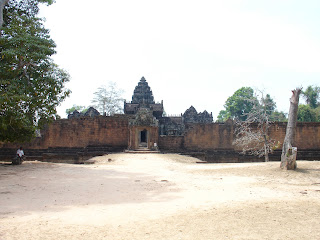



My last week in Dubai seems to have flown by. When I left England back in November last year, I thought that coming home would be ages away but I can't believe the trip is at and end and I fly home tomorrow morning. When I look back at my trip, I really have done a lot but I am looking forward to coming home and seeing everyone (especially Vernon) and as I am spent up, it is about time I earnt some money!
True to form, my mum and I spent rather a lot of time this week in the shops buying jewellery (she didn't, I did). Anyone who knows me well will know that I am an avid jewellery wearer and for some reason, when I come to Dubai, I can't resist all the designs, especially the diamonds and the Italian jewellery. There is a shopping centre called the Gold & Diamond Park near where my parents live and my mum has been there so many times to buy for herself and with her friends, that she gets very good discounts (about 70% off the price). I am surprised they don't give her commission for the anount of business she brings their way. When you factor in the discounts and the fact that everything is a lot cheaper than the UK, I just can't resist! My dad thinks I need to go to shopaholics anonymous and when it comes to jewellery - I think he must be right!!
We also went to have a pamper session in the week - a manicure, pedicure and a facial. The woman doing the manicure and the pedicure was very good but the woman doing the facial must have thought she was ploughing the fields, as she was very rough. At one point I thought she was going to lascerate my face with the blackhead remover. Then she had the nerve to say it hurt because I had never had it done before. She was from the Phillipines, so I think that maybe their idea of pampering is different to mine.
I have done my fair bit of eating out too - Dubai is cheaper than the UK for eating out, but not as cheap as South East Asia. The quality of the food is very good, especially in the hotel restaurants. On Thursday my mum invited some of her friends around for dinner and I cooked Thai food which I learnt on the cookery course in Chiang Mai back in January - tom yum soup, yellow curry and chicken and cashew nuts. I had to apologise in advance for the soup, as it nearly blew everyone's brains out for being so hot (I only put three chillis in, so I don't understand why it was so hot). I like it with a bit of a kick though.
When I came back to Dubai (having last been here at Christmas 2006), there were a lot of new buildings and roads and some of the shopping malls had also been extended. Some of the malls are quite quiet and it is a blissful experience going around them compared to the nightmare of Oxford Street. Dubai must be the biggest construction site in the world - it is staggering how much building is going on. Today we went to have a look at Dubai Sports City, where they are building a Manchester United Sports Stadium, an Autodrome and various sports academies. We went to have a look at some of the villas which were being built on the site and they are absolutely huge (and you get a separate room for the maid). Each bedroom has its own ensuite. That site alone is 50 million square metres. Most of the buyers of properties are foreign investors who snap up whole floors from the developers and then sell them off individually on the secondary market at a profit. Great if you have a load of spare cash.
I do love Dubai - apart from four months in the summer when it is unbearably hot, it is sunny. It is very liberal in certain respects (you don't need to cover up as in other Muslim countries) but it is also quite behind the times. For example, I read in the paper the other day that a couple (Indonesian I think) who were living together had a bust up because the guy farted (the paper said he "broke wind") in bed. The woman was so incensed that they had an argument and it resulted in a punch up. The police were called but they were charged with having an immoral relationship, as they were living together but not married (which is against the law). They had to pay a hefty fine. Not a very bright couple, if you ask me. All this from a country which is building the tallest building in the world, the Burj Dubai, which at today's count, has 156 floors (no one other than the builders know how tall it will eventually be). I also heard yesterday that the government was thinking of building a giant city suspended in the air in a helium balloon. Someone has more money than sense somewhere (environmental issues are not a big concern here).
By the time some of you read this I shall be on a plane home - my last experience of living it up in business class. I hear the weather has been cold, so good job I have some thermals to hand!
Key to photos (from left to right):
1. Burj al Arab and Jumeirah Beach hotels - view from Palm Island
2. View from my parents' flat
3. Largest mosque for foreigners's use
4. Another view from my parent's flat
5. View of the pool from my parents' flat



























